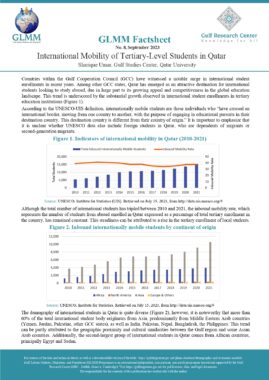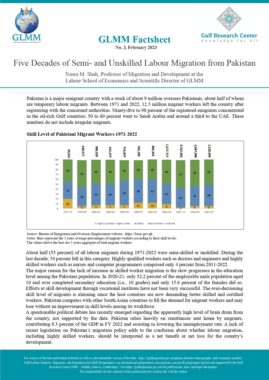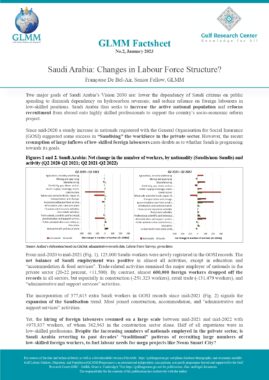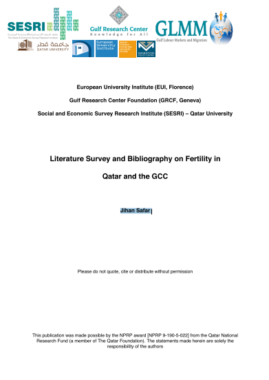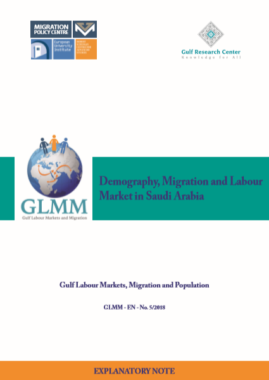Bahrain: Estimated population employed in the public sector by nationality (Bahraini/non-Bahraini) and sex (Q1 2012 – Q2 2023)
| Bahrainis | Non-Bahrainis | Total | |||||||
| Males | Females | Total | Males | Females | Total | Males | Females | Total | |
| 2012: Q1 | 26,867 | 22,206 | 49,073 | 6,026 | 2,303 | 8,329 | 32,893 | 24,509 | 57,402 |
| Q2 | 27,446 | 24,486 | 51,932 | 5,979 | 2,433 | 8,412 | 33,425 | 26,919 | 60,344 |
| Q3 | 27,449 | 24,477 | 51,926 | 6,286 | 2,447 | 8,733 | 33,735 | 26,924 | 60,659 |
| Q4 | 27,614 | 24,629 | 52,243 | 6,399 | 2,505 | 8,904 | 34,013 | 27,134 | 61,147 |
| 2013: Q1 | 27,623 | 25,225 | 52,848 | 6,473 | 2,613 | 9,086 | 34,096 | 27,838 | 61,934 |
| Q2 | 30,145 | 26,390 | 56,535 | 6,455 | 2,691 | 9,146 | 36,600 | 29,081 | 65,681 |
| Q3 | 30,115 | 26,550 | 56,665 | 6,644 | 2,889 | 9,533 | 36,759 | 29,439 | 66,198 |
| Q4 | 30,169 | 26,696 | 56,865 | 6,786 | 3,160 | 9,946 | 36,955 | 29,856 | 66,811 |
| 2014: Q1 | 30,213 | 26,775 | 56,988 | 6,834 | 3,176 | 10,010 | 37,047 | 29,951 | 66,998 |
| Q2 | 30,037 | 26,780 | 56,817 | 6,736 | 3,082 | 9,818 | 36,773 | 29,862 | 66,635 |
| Q3 | 30,053 | 26,778 | 56,831 | 6,854 | 3,342 | 10,196 | 36,907 | 30,120 | 67,027 |
| Q4 | 30,263 | 26,856 | 57,119 | 6,906 | 3,335 | 10,241 | 37,169 | 30,191 | 67,360 |
| 2015: Q1 | 30,061 | 27,000 | 57,061 | 6,861 | 3,320 | 10,181 | 36,922 | 30,320 | 67,242 |
| Q2 | 30,054 | 27,183 | 57,237 | 6,726 | 3,227 | 9,953 | 36,780 | 30,410 | 67,190 |
| Q3 | 29,986 | 27,185 | 57,171 | 6,861 | 3,384 | 10,245 | 36,847 | 30,569 | 67,416 |
| Q4 | 29,867 | 27,263 | 57,130 | 6,916 | 3,493 | 10,409 | 36,783 | 30,756 | 67,539 |
| 2016: Q1 | 29,340 | 27,092 | 56,432 | 6,818 | 3,448 | 10,266 | 36,158 | 30,540 | 66,698 |
| Q2 | 29,138 | 27,036 | 56,174 | 6,675 | 3,356 | 10,031 | 35,813 | 30,392 | 66,205 |
| Q3 | 28,672 | 26,801 | 55,473 | 6,639 | 3,329 | 9,968 | 35,311 | 30,130 | 65,441 |
| Q4 | 28,441 | 26,511 | 54,952 | 6,679 | 3,328 | 10,007 | 35,120 | 29,839 | 64,959 |
| 2017: Q1 | 28,018 | 26,701 | 54,719 | 6,684 | 3,316 | 10,000 | 34,702 | 30,017 | 64,719 |
| Q2 | 27,962 | 26,838 | 54,800 | 6,613 | 3,270 | 9,883 | 34,575 | 30,108 | 64,683 |
| Q3 | 27,708 | 26,828 | 54,536 | 6,590 | 3,263 | 9,853 | 34,298 | 30,091 | 64,389 |
| Q4 | 27,693 | 26,920 | 54,613 | 6,605 | 3,275 | 9,880 | 34,298 | 30,195 | 64,493 |
| 2018: Q1 | 27,236 | 26,741 | 53,977 | 6,616 | 3,249 | 9,865 | 33,852 | 29,990 | 63,842 |
| Q2 | 27,130 | 26,802 | 53,932 | 6,555 | 3,175 | 9,730 | 33,685 | 29,977 | 63,662 |
| Q3 | 26,867 | 26,821 | 53,688 | 6,490 | 3,136 | 9,626 | 33,357 | 29,957 | 63,314 |
| Q4 | 26,870 | 27,077 | 53,947 | 6,504 | 3,131 | 9,635 | 33,374 | 30,208 | 63,582 |
| 2019: Q1 | 23,702 | 25,569 | 49,271 | 6,509 | 3,125 | 9,634 | 30,211 | 28,694 | 58,905 |
| Q2 | 22,557 | 24,155 | 46,712 | 6,408 | 3,060 | 9,468 | 28,965 | 27,215 | 56,180 |
| Q3 | 22,385 | 23,745 | 46,130 | 6,312 | 3,016 | 9,328 | 28,697 | 26,761 | 55,458 |
| Q4 | 22,694 | 24,189 | 46,883 | 6,245 | 2,979 | 9,224 | 28,939 | 27,168 | 56,107 |
| 2020: Q1 | 22,721 | 24,714 | 47,435 | 6,171 | 3,012 | 9,183 | 28,892 | 27,726 | 56,618 |
| Q2 | 22,776 | 25,011 | 47,787 | 6,171 | 3,163 | 9,334 | 28,947 | 28,174 | 57,121 |
| Q3 | 22,766 | 25,080 | 47,846 | 6,080 | 3,369 | 9,449 | 28,846 | 28,449 | 57,295 |
| Q4 | 22,764 | 25,229 | 47,993 | 5,959 | 3,479 | 9,438 | 28,723 | 28,708 | 57,431 |
| 2021: Q1 | 22,688 | 25,310 | 47,998 | 5,835 | 3,448 | 9,283 | 28,523 | 28,758 | 57,281 |
| Q2 | 22,655 | 25,474 | 48,129 | 5,872 | 3,553 | 9,425 | 28,527 | 29,027 | 57,554 |
| Q3 | 22,651 | 25,595 | 48,246 | 5,803 | 3,483 | 9,286 | 28,454 | 29,078 | 57,532 |
| Q4 | 22,761 | 25,890 | 48,651 | 5,740 | 3,464 | 9,204 | 28,501 | 29,354 | 57,855 |
| 2022: Q1 | 22,863 | 26,230 | 49,093 | 5,687 | 3,423 | 9,110 | 28,550 | 29,653 | 58,203 |
| Q2 | 22,976 | 26,489 | 49,465 | 5,582 | 3,372 | 8,954 | 28,558 | 29,861 | 58,419 |
| Q3 | 23,085 | 26,676 | 49,761 | 5,441 | 3,341 | 8,782 | 28,526 | 30,017 | 58,543 |
| Q4 | 23,166 | 27,076 | 50,242 | 5,346 | 3,303 | 8,649 | 28,512 | 30,379 | 58,891 |
| 2023: Q1 | 22,934 | 27,025 | 49,959 | 5,263 | 3,270 | 8,533 | 28,197 | 30,295 | 58,492 |
| Q2 | 22,483 | 26,949 | 49,432 | 5,042 | 3,119 | 8,161 | 27,525 | 30,068 | 57,593 |
Source: BLMI, Labour Market Regulation Authority (LMRA)
ANNEXED NOTE
1. Technical Notes and Definitions
Data are extracted from the files submitted by Expatriate Management System (LMRA-EMS), General Organisation for Social Insurance (GOSI), Pension Fund Commission (PFC), and Civil Service Bureau (CSB) monthly data files to LMRA.Estimates of employed population include all civilian employed persons in the private and public sectors (insured, uninsured and self-employed) and domestic workers.
LMRA data do not include non-civilian employees (engaged in military, defense and other relevant entities and ranked as so).
1. From 2008 Q2 onward, “Public sector” for non-Bahraini workers refers to workers in the “Government sector” of the Expatriate Management System (EMS) of LMRA.
2. “Private Sector” for non-Bahraini workers refers to the sum of “Commercial” and “Non-Commercial, Non-Government” (NCNG) sectors of LMRA’s EMS system.
3. Male population includes persons with unrecorded sex attribute.
4. Details may not add up to totals due to rounding error. Also, data from this table may differ from totals obtained from other tables in the series (Tables A1, A2, A06, A07, A10 and A99).
5. The drop in number of domestic workers in Q2 2018 is due to data cleansing of domestic records during Q2 at LMRA
6. From the period 2019 Q1 onwards the Domestic permit counts have been reviewed to include the domestic workers holding active work permits in addition to in-progress permits issued with a residence permit. The count also includes domestic permits due for renewal that have not been terminated or cancelled by the employer.
Employment as defined by the LMRA is in line with the ILO resolution concerning statistics of the economically active population, employment, unemployment and underemployment.
It includes all persons above a specific age during a specific period either in paid employment or in self-employment and includes the following:
(a) paid employment
(a1) at work: persons who during the reference period performed some work for wage or salary, in cash or in kind, even for one hour
(a2) with a job but not at work: persons who, having already worked in their present job, were temporarily not at work during the reference period and had a formal attachment to their job(e.g., absence because of illness or injury, holiday or vacation, strike or lockout, educational or training leave, maternity or parental leave, reduction in economic activity, etc.)
(b) self employment
(b1) at work: persons who during the reference period performed some work for profit or family gain, in cash or in kind
(b2) with an enterprise but not at work: persons with an enterprise, which may be a business enterprise, a farm or a service undertaking, who were temporarily not at work during the reference period for any specific reason.
Estimates of employed population are no longer available in the Bahrain Labour Market Indicators (BLMI) publications after Q2 2023.
2. Institution which provides data
Labour Market Regulatory Authority (LMRA)
https://www.lmra.gov.bh/en/home
3. Data availability
Labour Market Regulatory Authority (LMRA), Kingdom of Bahrain, based on data from Bahrain Labour Market Indicators.
https://blmi.lmra.gov.bh/2023/06/data/lmr/Table_A.pdf
Data are tabulated in PDF format.
The definitions that the LMRA adopts for its data can be found in the Glossary section:
https://blmi.lmra.gov.bh/mi_glossary.xml
Date of access: September 2024.
GLMM and GRC cannot guarantee that the link to access the source will not change;
that the information will not be removed from the website it was obtained from;
that no geo-blockages will be imposed; or that the information will not be available for any another reason.
Keywords: Bahrain, National Labour, Foreign Labour, Employment, Female Employment, Domestic Workers
Similar Posts:
- Bahrain: Estimated population employed in the domestic sector by nationality (Bahraini/non-Bahraini) and sex (Q1 2012 – Q2 2023)
- Bahrain: Estimated total employed population by nationality (Bahraini/non-Bahraini) and sector (public, private, domestic) (Q1 2018-Q4 2022)
- Bahrain: Estimated population employed in the private sector by nationality (Bahraini/non-Bahraini) and sex (Q1 2012 – Q2 2023)
- Bahrain: Estimated total employed population by nationality (Bahraini/Non-Bahraini) and sector (public, private, domestic) (Quarterly: Q1 2014 – Q2 2018)
- Bahrain: Domestic workers by sex (Q1 2016-Q4 2022)
Tags: Bahrain, Domestic Workers, Employment, Female Employment, Foreign Labour, National Labour

































